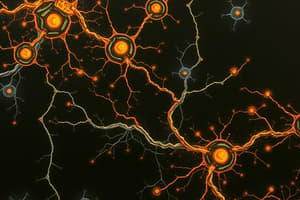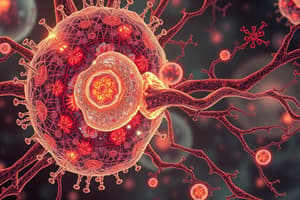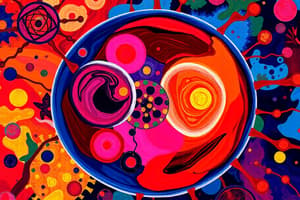Podcast
Questions and Answers
What is the primary role of neurotransmitters in cellular signaling?
What is the primary role of neurotransmitters in cellular signaling?
- They facilitate direct contact between adjacent cells.
- They maintain the structure of cell membranes.
- They are involved in local signaling by acting on nearby target cells. (correct)
- They act as hormones traveling long distances.
Which type of cell signaling involves the release of messenger molecules that travel short distances?
Which type of cell signaling involves the release of messenger molecules that travel short distances?
- Synaptic signaling
- Endocrine signaling
- Autocrine signaling
- Paracrine signaling (correct)
What is the initial event that occurs when a ligand binds to a receptor?
What is the initial event that occurs when a ligand binds to a receptor?
- The receptor is released from the cell membrane.
- The receptor is internalized into the cell.
- The ligand is decomposed into smaller molecules.
- The receptor undergoes a shape change. (correct)
Which type of receptor is most abundant on human cell surfaces?
Which type of receptor is most abundant on human cell surfaces?
How do hormones act in long-distance signaling?
How do hormones act in long-distance signaling?
What structural feature characterizes G-protein-coupled receptors (GPCR)?
What structural feature characterizes G-protein-coupled receptors (GPCR)?
Which of the following statements about ion channel receptors is true?
Which of the following statements about ion channel receptors is true?
What role does GTP play in the function of G-proteins?
What role does GTP play in the function of G-proteins?
What is the primary role of apoptosis in cellular processes?
What is the primary role of apoptosis in cellular processes?
Which of the following best describes the initiation of apoptosis from external signals?
Which of the following best describes the initiation of apoptosis from external signals?
What occurs to the cell contents during apoptosis?
What occurs to the cell contents during apoptosis?
What triggers the first internal signal that leads to apoptosis?
What triggers the first internal signal that leads to apoptosis?
How does a cell recover its ability to receive new signals after an apoptosis event?
How does a cell recover its ability to receive new signals after an apoptosis event?
What is the primary role of G proteins in cellular signaling?
What is the primary role of G proteins in cellular signaling?
How do receptor tyrosine kinases (RTKs) function in cellular responses?
How do receptor tyrosine kinases (RTKs) function in cellular responses?
What initiates the opening of the gate in ion channel receptors?
What initiates the opening of the gate in ion channel receptors?
Where are intracellular receptors primarily located?
Where are intracellular receptors primarily located?
What is a key feature of the transduction stage in signaling pathways?
What is a key feature of the transduction stage in signaling pathways?
Which of the following describes the process by which steroid hormones exert their effect?
Which of the following describes the process by which steroid hormones exert their effect?
What happens after a ligand binds to a receptor tyrosine kinase?
What happens after a ligand binds to a receptor tyrosine kinase?
What role do small molecules play in signal transduction pathways?
What role do small molecules play in signal transduction pathways?
What role does the final activated molecule in the nucleus play?
What role does the final activated molecule in the nucleus play?
Which of the following represents an example of a cytoplasmic response to signaling?
Which of the following represents an example of a cytoplasmic response to signaling?
What aspect of signal regulation involves increasing the number of activated products in a pathway?
What aspect of signal regulation involves increasing the number of activated products in a pathway?
What is the primary function of protein kinases in signal transduction pathways?
What is the primary function of protein kinases in signal transduction pathways?
How does signaling specificity affect cell response to a signal?
How does signaling specificity affect cell response to a signal?
What role do protein phosphatases play in cellular signaling?
What role do protein phosphatases play in cellular signaling?
What is the function of scaffolding proteins in signal transduction?
What is the function of scaffolding proteins in signal transduction?
Why is signal termination important in multicellular organisms?
Why is signal termination important in multicellular organisms?
Which of the following is NOT a widely used second messenger?
Which of the following is NOT a widely used second messenger?
What effect does a small number of signaling molecules have during signal amplification?
What effect does a small number of signaling molecules have during signal amplification?
During the cyclic AMP pathway, what causes the activation of protein kinase A?
During the cyclic AMP pathway, what causes the activation of protein kinase A?
What is the initial event that occurs in the cyclic AMP signaling pathway?
What is the initial event that occurs in the cyclic AMP signaling pathway?
Which term describes the capability of different cells to activate distinct genes in response to the same signal?
Which term describes the capability of different cells to activate distinct genes in response to the same signal?
What cellular response is triggered by the release of calcium ions into the cytoplasm?
What cellular response is triggered by the release of calcium ions into the cytoplasm?
IP3 is involved in signaling primarily by facilitating the release of which ion?
IP3 is involved in signaling primarily by facilitating the release of which ion?
Which of the following accurately describes second messengers?
Which of the following accurately describes second messengers?
Flashcards are hidden until you start studying
Study Notes
Cell Signaling
- Cells communicate with each other and their environment through signaling molecules.
- These signaling processes are similar across various species.
Local Signaling
-
Direct contact between cells:
- Cell junctions: Tightly connected cells pass information through junctions.
- Cell-cell recognition: Membrane-bound molecules on cell surfaces interact for communication.
-
Short-distance signaling through secreted molecules:
- Paracrine Signaling: A cell secretes local regulators that influence nearby target cells.
- Example: Growth factors
- Synaptic Signaling: A nerve cell releases neurotransmitters into a synapse, affecting a target cell.
- Example: Neurotransmitters in the nervous system
- Paracrine Signaling: A cell secretes local regulators that influence nearby target cells.
Long-Distance Signaling
- Animals and plants use hormones for long-distance signaling.
- Endocrine Signaling (in animals): Specialized cells release hormones that are transported to other parts of the body through the circulatory system.
Reception
- Signaling molecules (ligands) bind to specific receptor proteins, triggering a change in the receptor's shape.
- Receptor activation initiates downstream effects.
Types of Receptors
-
Plasma Membrane Receptors:
- G-Protein-Coupled Receptors (GPCR):
- Most abundant type of human cell surface receptors.
- Transmembrane receptors that use a G protein to relay signals inside the cell.
- G proteins bind to GTP (guanosine triphosphate), a high-energy molecule.
- Diverse functions, including vision, smell, and taste.
- Example: Rhodopsin, a GPCR responsible for light detection in rod cells.
- Receptor Tyrosine Kinases (RTK):
- Act as dimers (pairs) when activated by a signal.
- Have enzymatic activity (kinase), phosphorylating tyrosine residues on target proteins.
- Can activate multiple signal transduction pathways.
- Example: Growth factor receptors involved in cell growth, division, and differentiation.
- Ion Channel Receptors:
- Open or close channels in response to a ligand, allowing or blocking ion flow.
- Important role in the nervous system.
- Some are activated by electrical or mechanical signals instead of ligands.
- Example: Neurons use ion channels to transmit electrical signals.
- G-Protein-Coupled Receptors (GPCR):
-
Intracellular Receptors:
- Located in the cytoplasm or nucleus.
- Bind to signaling molecules that can pass through the plasma membrane (usually hydrophobic and small).
- Example: Steroid hormones.
Transduction
-
A multi-step process that involves many molecules and relays signals inside the cell.
-
Key Processes:
- Protein Phosphorylation and Dephosphorylation:
- Phosphorylation: Protein kinases add phosphate groups to proteins, often activating them.
- Dephosphorylation: Protein phosphatases remove phosphate groups, deactivating proteins.
- The balance between phosphorylation and dephosphorylation controls protein activity.
- Small Molecules and Ions as Second Messengers:
- Extracellular signaling molecules (first messengers) activate intracellular messengers (second messengers).
- Second messengers amplify and disseminate signals within cells.
- Common examples: cyclic AMP (cAMP), calcium ions (Ca2+).
- Protein Phosphorylation and Dephosphorylation:
Second Messenger Pathways
- Cyclic AMP (cAMP) Pathway:
- Ligand binds to a GPCR, activating a G protein.
- The activated G protein stimulates adenylyl cyclase.
- Adenylyl cyclase converts ATP into cAMP.
- cAMP activates protein kinase A, triggering cellular responses.
- IP3 and Calcium Ions:
- IP3 (inositol 1,4,5-triphosphate) and DAG (diacylglycerol) act as second messengers.
- IP3 triggers release of calcium ions from intracellular stores.
- Calcium ions play roles in:
- Muscle contraction
- Vesicle fusion and exocytosis
- Glycogen metabolism
Responses
- Signal transduction pathways lead to changes in cellular activity.
- Responses can occur in the nucleus or the cytoplasm.
- Nuclear Responses:
- Activated molecules in the pathway often function as transcription factors, regulating gene expression.
- This leads to protein synthesis or protein inactivation.
- Cytoplasmic Responses:
- Signaling pathways can directly affect proteins outside the nucleus.
- Example: Opening or closing of ion channels, changes in metabolism.
Regulation of Signal Transduction
- Signal Amplification:
- Enzyme cascades amplify the initial signal, resulting in a large cellular response.
- Each step in the cascade produces more activated molecules than the previous step.
- Signaling Specificity:
- Different cell types express different sets of receptor, relay, and response proteins.
- This explains why cells respond differently to the same signal.
- Signaling Efficiency:
- Scaffolding proteins gather proteins in a pathway, increasing efficiency.
- Signal Termination:
- The ability of a cell to receive new signals relies on the reversibility of changes made by past signals.
- The signaling pathway must be switched off for the cell to respond to new signals.
Apoptosis (Programmed Cell Death)
- Cells with damaged DNA or reaching the end of their lifespan undergo apoptosis.
- Apoptosis involves a series of events that dismantle the cell. The cell shrinks, DNA is fragmented, and components are eventually engulfed by scavenger cells.
- Apoptosis prevents damage to surrounding cells.
Apoptotic Pathways
- Apoptotic signals can originate from outside or inside the cell.
- External Signals:
- Signaling molecules from other cells can initiate apoptosis.
- Example: Tumor necrosis factor (TNF) triggers apoptosis in tumor cells.
- Internal Signals:
- DNA damage or excessive protein misfolding within a cell can trigger an apoptotic signal.
Studying That Suits You
Use AI to generate personalized quizzes and flashcards to suit your learning preferences.




